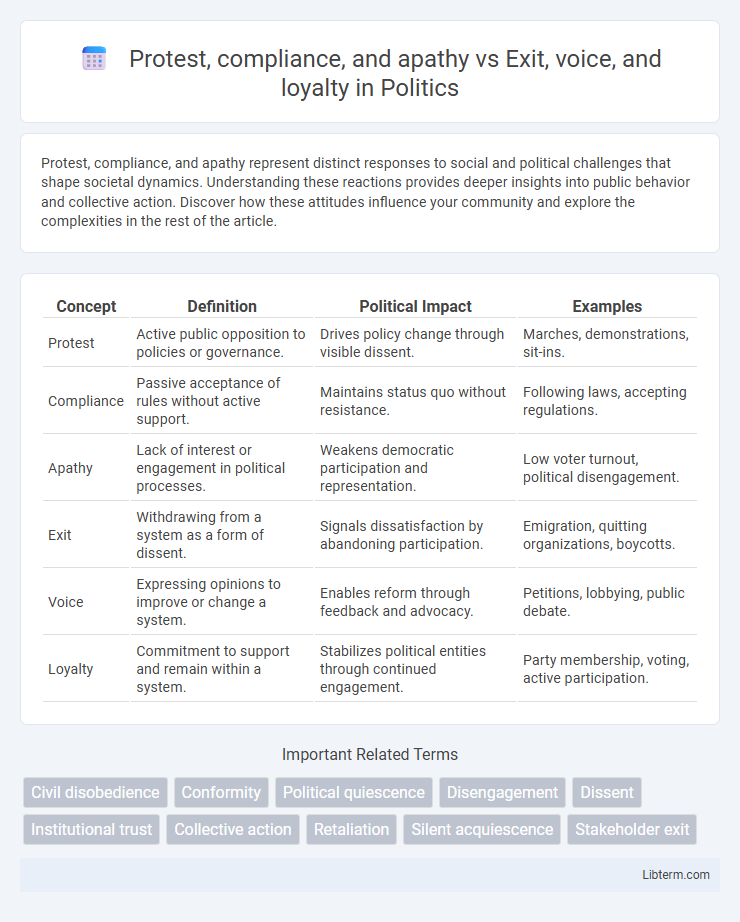Protest, compliance, and apathy represent distinct responses to social and political challenges that shape societal dynamics. Understanding these reactions provides deeper insights into public behavior and collective action. Discover how these attitudes influence your community and explore the complexities in the rest of the article.
Table of Comparison
| Concept | Definition | Political Impact | Examples |
|---|---|---|---|
| Protest | Active public opposition to policies or governance. | Drives policy change through visible dissent. | Marches, demonstrations, sit-ins. |
| Compliance | Passive acceptance of rules without active support. | Maintains status quo without resistance. | Following laws, accepting regulations. |
| Apathy | Lack of interest or engagement in political processes. | Weakens democratic participation and representation. | Low voter turnout, political disengagement. |
| Exit | Withdrawing from a system as a form of dissent. | Signals dissatisfaction by abandoning participation. | Emigration, quitting organizations, boycotts. |
| Voice | Expressing opinions to improve or change a system. | Enables reform through feedback and advocacy. | Petitions, lobbying, public debate. |
| Loyalty | Commitment to support and remain within a system. | Stabilizes political entities through continued engagement. | Party membership, voting, active participation. |
Understanding Protest, Compliance, and Apathy: Key Social Responses
Protest, compliance, and apathy represent critical social responses reflecting individuals' engagement with authority and policies, where protest signals active resistance, compliance denotes adherence, and apathy indicates disengagement or indifference. Understanding these behaviors provides insights into public sentiment and the effectiveness of governance, contrasting with Hirschman's framework of exit, voice, and loyalty that categorizes responses as leaving, expressing concerns, or supporting an institution. Analyzing the dynamics between protest, compliance, apathy, and exit, voice, loyalty enhances the comprehension of societal reactions and the mechanisms driving social change.
Exit, Voice, and Loyalty: Hirschman’s Framework Explained
Hirschman's framework of Exit, Voice, and Loyalty delineates how individuals or groups respond to decline in organizations or states, with Exit representing departure, Voice signaling active feedback or protest, and Loyalty moderating the choice between them. Exit occurs when members leave a deteriorating situation, Voice involves efforts to improve conditions through expression and protest, and Loyalty sustains members' attachment, reducing the likelihood of Exit by encouraging perseverance. This model provides critical insights into organizational behavior and political response, emphasizing the dynamic interplay between compliance, apathy, and active engagement.
Comparing Protest and Voice: Channels of Expression
Protest represents direct, often public actions challenging authority through demonstrations or civil disobedience, leveraging visibility to demand change. Voice, as a channel of expression, involves constructive communication within established systems, such as petitions or dialogue aimed at reforming policies. While protest seeks immediate impact through external pressure, voice operates internally, promoting gradual improvements through engagement and negotiation.
When Compliance Meets Loyalty: The Dynamics of Obedience
When compliance intersects with loyalty, individuals often exhibit obedience driven by deep-seated allegiance rather than mere rule-following. This dynamic transforms passive compliance into active loyalty, reinforcing organizational or societal stability through emotional and cognitive commitment. Understanding this interplay clarifies why some members choose loyalty-infused obedience over protest or apathy in the face of governance or authority.
From Apathy to Exit: Choosing Disengagement
Apathy in organizational contexts often leads to disengagement, shifting individuals from passive indifference to active exit, where they withdraw participation or leave the group entirely. This transition contrasts with voice and loyalty strategies, where members either express concerns to influence change or remain committed despite dissatisfaction. Understanding the move from apathy to exit highlights the critical role of engagement mechanisms in preventing loss of valuable participation and maintaining organizational resilience.
Social Movements: The Role of Protest and Voice
Protest and compliance represent active and passive responses within social movements, where protest involves collective action to challenge injustice, while compliance indicates acquiescence to existing conditions. Exit, voice, and loyalty theory frames these responses by emphasizing the choice between leaving a group (exit), expressing dissatisfaction (voice), or remaining loyal despite grievances. Protest and voice serve as vital mechanisms for marginalized groups to demand change, highlighting the dynamic interplay between individual agency and institutional responses in social movement strategies.
Institutional Responses: Encouraging Loyalty or Enforcing Compliance
Institutional responses to dissent often balance encouraging loyalty and enforcing compliance to stabilize governance and maintain order. Protest, compliance, and apathy reflect varying levels of citizen engagement, where apathy indicates disengagement while compliance suggests passive acceptance of institutional norms. Exit, voice, and loyalty clarify actor strategies, with loyalty fostering long-term allegiance, voice enabling active participation or protest, and exit representing withdrawal from the system, influencing how institutions design policies to either incentivize loyalty or impose compliance mechanisms.
Navigating Change: The Interplay between Exit, Voice, and Protest
Navigating change involves understanding the interplay between exit, voice, and protest as key responses to dissatisfaction within organizations or social systems. Protest acts as a collective expression of discontent often accompanied by compliance or apathy, while exit represents the decision to leave, and voice entails advocating for change from within. Balancing these mechanisms influences how effectively groups manage conflict and implement reforms during periods of transformation.
Practical Implications: Managing Apathy and Promoting Engagement
Addressing apathy in organizations requires strategic management that balances compliance enforcement with fostering active participation through exit, voice, and loyalty mechanisms. Practical interventions include creating transparent communication channels that encourage voice, implementing feedback systems to reduce protest, and offering incentives that increase loyalty, thereby minimizing disengagement. Organizations that proactively manage these dynamics enhance employee satisfaction, reduce turnover, and improve overall operational performance.
Building Resilient Systems: Balancing Compliance, Loyalty, and Dissent
Building resilient systems requires balancing compliance, loyalty, and dissent by integrating mechanisms for protest and apathy alongside exit, voice, and loyalty strategies. Effective governance incorporates channels for expressing grievances to prevent system breakdowns while maintaining stakeholder commitment through compliant behaviors and loyalty incentives. This equilibrium fosters adaptability and stability, enhancing the system's capacity to respond constructively to internal and external stresses.
Protest, compliance, and apathy Infographic

 libterm.com
libterm.com